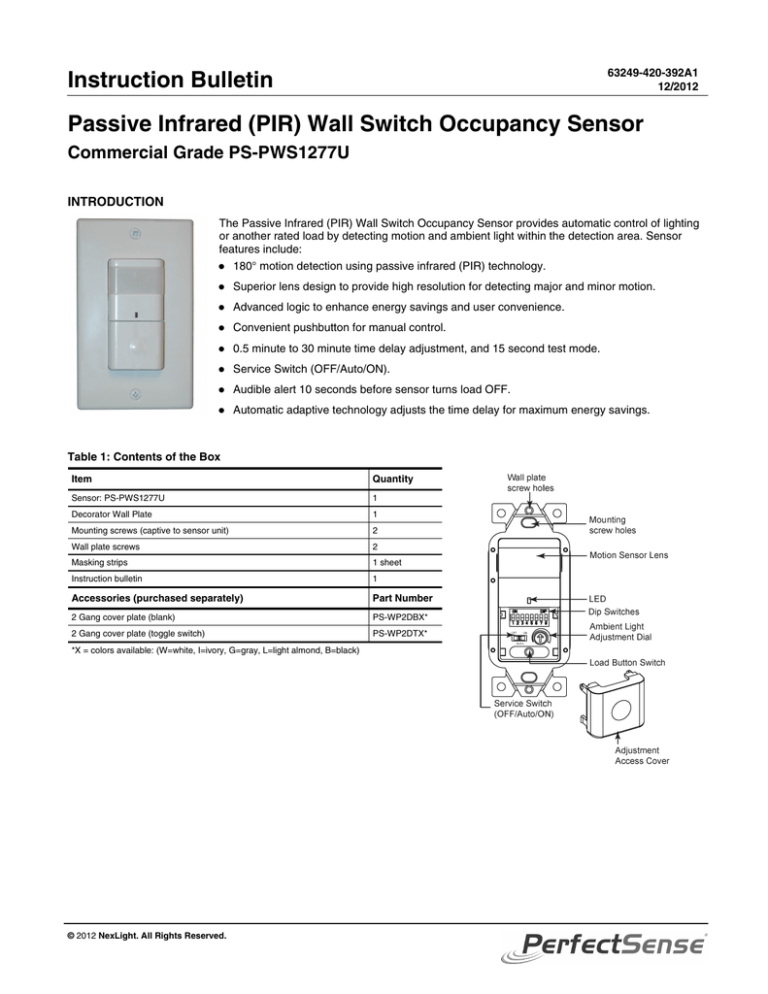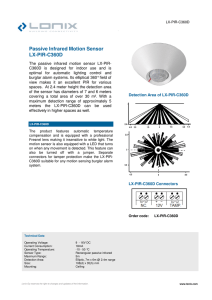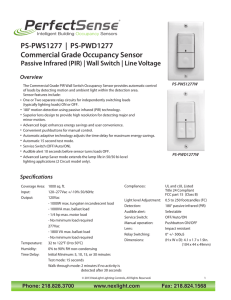
63249-420-392A1
12/2012
Instruction Bulletin
Passive Infrared (PIR) Wall Switch Occupancy Sensor
Commercial Grade PS-PWS1277U
INTRODUCTION
The Passive Infrared (PIR) Wall Switch Occupancy Sensor provides automatic control of lighting
or another rated load by detecting motion and ambient light within the detection area. Sensor
features include:
180° motion detection using passive infrared (PIR) technology.
Superior lens design to provide high resolution for detecting major and minor motion.
Advanced logic to enhance energy savings and user convenience.
Convenient pushbutton for manual control.
0.5 minute to 30 minute time delay adjustment, and 15 second test mode.
Service Switch (OFF/Auto/ON).
Audible alert 10 seconds before sensor turns load OFF.
Automatic adaptive technology adjusts the time delay for maximum energy savings.
Table 1: Contents of the Box
Item
Quantity
Sensor: PS-PWS1277U
1
Decorator Wall Plate
1
Mounting screws (captive to sensor unit)
2
Wall plate screws
2
Masking strips
1 sheet
Instruction bulletin
1
Accessories (purchased separately)
Part Number
2 Gang cover plate (blank)
PS-WP2DBX*
2 Gang cover plate (toggle switch)
PS-WP2DTX*
*X = colors available: (W=white, I=ivory, G=gray, L=light almond, B=black)
© 2012 NexLight. All Rights Reserved.
Passive Infrared (PIR) Wall Switch Occupancy Sensor
Instruction Bulletin
63249-420-392A1
12/2012
Table 2: Sensor Standards and Specifications
UL and cUL Listed
Standards
FCC part 15 for Home and Office Use (Class B)
Specifications
Input:
120 through 277Vac +/-10% 50/60Hz
Output:
120Vac
- 1000W max. tungsten incandescent load
- 1000VA max. ballast load
- 1/4 hp max. motor load
277Vac
- 1800 VA max. ballast load
No minimum load required
Temperature:
32 to 122°F (0 to 50°C)
Humidity:
0% to 90% RH non-condensing
Time delay adjustment:
Normal:
0.5 to 30 minutes
Walk through mode:
2 minutes if no activity is detected after 30 seconds
Test mode:
15 seconds
Light level adjustment:
0.5 to 250 footcandles (FC)
Detection:
180° passive infrared (PIR)
Audible alert:
Selectable
Service Switch:
OFF/Auto/ON
Manual operation:
Pushbutton ON/OFF
Lens:
Impact resistant
Relay Switching:
0° +/- 500uS
Physical dimensions of Unit as illustrated under
"Contents of the Box" section (H x W x D):
4.1 x 1.7 x 1.9in. (104 x 44 x 49mm)
LOCATION AND COVERAGE AREA
The sensor provides major motion detection up to 1000 sq. ft., and minor motion detection up to
300 sq. ft.
Consider the placement of furniture when selecting a mounting location for the sensor. Select an
unobstructed location from the sensor to areas of high occupancy, such as a desk, so that the sensor
easily detects minor movements.
Peel and stick the masking strips (provided) to the motion sensor lens to reduce the motion coverage
area, if required.
2
© 2012 Nexlight. All Rights Reserved.
63249-420-392A1
12/2012
Passive Infrared (PIR) Wall Switch Occupancy Sensor
Instruction Bulletin
CLASS B FCC STATEMENT
This device complies with Part 15 of the FCC Rules. Operation is subject to the following two conditions: (1) this
device may not cause harmful interference, and (2) this device must accept any interference received, including
interference that may cause undesired operation.
This equipment has been tested and found to comply with the limits for a Class B digital device, pursuant to Part 15
of the FCC Rules. These limits are designed to provide reasonable protection against harmful interference in a
residential installation. This equipment generates, uses, and can radiate radio frequency energy and, if not installed
and used in accordance with the instructions, may cause harmful interference to radio communications. However,
there is no guarantee that interference will not occur in a particular installation. If this equipment does cause harmful
interference to radio or television reception, which can be determined by turning the equipment off and on, the user
is encouraged to try to correct the interference by one or more of the following measures:
Reorient or relocate the receiving antenna.
Increase the separation between the equipment and receiver.
Connect the equipment into an outlet on a circuit different from that to which the receiver is connected.
Consult the dealer or an experienced radio/TV technician for help.
Changes or modifications to this device that are not expressly approved by the manufacturer could void the user's
authority to operate this equipment.
SAFETY PRECAUTIONS
This section contains important safety precautions that must be followed before attempting to install or
maintain electrical equipment. Carefully read and follow the safety precautions below.
HAZARD OF ELECTRIC SHOCK, EXPLOSION, OR ARC FLASH
Apply appropriate personal protective equipment (PPE) and follow safe electrical work practices.
See NFPA 70E.
This equipment must be installed and serviced by qualified electrical personnel.
Turn off all electrical power supplying this equipment before working on or inside the equipment.
Always use a properly rated voltage sensing device to confirm that power is off.
Replace all devices, doors, and covers before turning on power to this equipment.
Failure to follow these instructions will result in death or serious injury.
INSTALLATION
NOTE: The unit conforms to NEMA WD 6 specifications.
To install the Passive Infrared (PIR) Wall Switch Occupancy Sensor:
1. Turn off power at the circuit breaker. Always use a properly rated voltage sensing device to confirm
power is off.
2. Remove existing switch, if applicable.
NOTE: Leave sensor dip switches in the factory default positions until sensor is installed. Refer to the
"Setting the Dip Switches" section for correct positions.
3. Wire the sensor according to the "Wiring Diagram" illustration.
4. Use one of the two methods described below to connect the ground wire (green) to a ground point.
Screw the ground wire directly to a metal wall box using the captive screw provided on the wire
Cut off the lug/screw combination and connect to a ground wire using a wire nut or other
approved method.
NOTE: The ground wire must be securely connected to the ground for proper operation.
5. Position the wires into the wall box and mount the sensor.
6. Secure the sensor to the box with the two longer mounting screws provided.
NOTE: The sensor must have an unobstructed view of the coverage area.
7. Attach the wall plate with the two short screws provided.
8. Turn on power at the circuit breaker. Wait three minutes for the sensor to properly initialize.
© 2012 Nexlight. All Rights Reserved.
3
Passive Infrared (PIR) Wall Switch Occupancy Sensor
Instruction Bulletin
63249-420-392A1
12/2012
Wiring Diagram
Figure 1: Wiring Diagram
ADJUSTING THE SETTINGS
Before making adjustments, squeeze the sides of the access cover together and gently pull
away from the sensor to remove the cover. The cover is located below the sensor LED.
Refer to the labeled sensor illustration for location. Replace the cover when adjustments are
complete.
Setting the Dip Switches
*Factory default shown.
Table 3: Dip Switch Sensor Functionality
Dip Switch
Functionality
Description
Position
ON
OFF
Assigns a duration to the length of time the loads stay on when
occupancy is not detected.
Automatic adaptive adjustment begins from this setting.
Refer to the "Setting the Minimum Time Delay" section.
-
-
-
-
-
-
1
Timeout Value
2
Timeout Value
3
Timeout Value
4
Activation
The load is turned on either automatically by detecting
occupancy, or manually by the user pressing the wall switch.
Auto ON*
Manual ON
5
Audible Alert
The sensor beeps to indicate the load will turn off in ten
seconds.
Enabled*
Disabled
6
Walk Through
Enabled
The sensor turns the load OFF two minutes after occupancy
detection if no motion is detected after the first 30 seconds. The
normal time delay applies if motion is detected after 30 seconds.
NOTE: Walk through mode is only effective for the time delay
settings greater than two minutes.
Disabled*
7
Reduced Sensitivity
Motion sensors detect occupancy within a smaller range (about
60%) when reduced sensitivity is enabled.
Enabled
Disabled*
8
Not used
Not used
-
-
* Default settings.
4
© 2012 Nexlight. All Rights Reserved.
63249-420-392A1
12/2012
Passive Infrared (PIR) Wall Switch Occupancy Sensor
Instruction Bulletin
Setting the Minimum Time Delay
To preserve lamp life and save energy, use the table below to select the time that most closely matches
the usage pattern within an area.
Table 4: Time Delay Duration Values
Time Delay
Dip Switch 1
Dip Switch 2
Dip Switch 3
30 seconds
OFF
OFF
OFF
2 minutes
ON
OFF
OFF
5 minutes
OFF
ON
OFF
10 minutes
ON
ON
OFF
15 minutes
OFF
OFF
ON
20 minutes*
ON
OFF
ON
25 minutes
OFF
ON
ON
30 minutes
ON
ON
ON
*Factory default setting.
The Sensor's automatic adaptive adjustment begins at the minimum time set using the dip switches.
The time delay is never adjusted to less than the selected time.
Light Level Adjustment (automatic mode only)
The Passive Infrared (PIR) Wall Switch Occupancy Sensor contains a light sensor that controls when
the load turns ON based on the light level. The sensor detects the ambient light level and enables or
disables the load based on the ambient light adjustment dial setting.
To select an ambient light level to turn the load ON:
1. Use a 1/8-inch flat-blade screwdriver to turn the ambient light adjustment dial.
2. Use the adjustment dial to set the operation of the load to one of the modes described in the table
below.
Table 5: Setting the Light Level Adjustment
Mode
Adjustment Dial Setting
Functionality
Manual ON operation
Fully counterclockwise.
The load does not turn ON in response to the ambient light level,
or when a user enters the room.
Automatic ambient light level
operation
Manually set between fully
counterclockwise and clockwise.
From the full counterclockwise position, slowly rotate the dial
while also making sufficient movement to trigger the sensor. Stop
when the load turns ON. When the area is occupied, the load
turns ON when the ambient light level is below the set level. To
prevent cycling, the load does not turn OFF when the light level
rises.
Automatic ON operation
(factory default)
Fully clockwise.
Turn the adjustment dial fully clockwise. The load ignores the
ambient light level, and always turns ON when a user enters the
room.
Setting the Service Switch
The service switch is used to bypass normal sensor operation. The sensor only responds to user
occupancy when the service switch is set to AUTO.
Table 6: Service Switch Settings
OFF
Load is forced OFF.
AUTO
The Sensor operates according to the selected settings.
ON
Load is forced ON.
© 2012 Nexlight. All Rights Reserved.
5
Passive Infrared (PIR) Wall Switch Occupancy Sensor
Instruction Bulletin
63249-420-392A1
12/2012
OPERATION
Table 7: Sensor Operation Settings
Setting
Description
Pushbutton
Push the front pushbutton to turn the lights ON and OFF.
Automatic ON Mode
Load turns ON automatically when occupancy is detected. The load automatically turns OFF after
the assigned time duration lapses, and no occupancy is detected.
If the pushbutton is used to turn lights OFF manually, the automatic ON setting is restored after 5
minutes unless occupancy is detected.
Automatic ON Mode is set using the fourth Dip Switch.
Manual ON Mode
The load does not turn ON automatically. Press the pushbutton to turn load ON when entering the
room. The load automatically turns OFF after the assigned time duration lapses, and no
occupancy is detected.
There is a 30 second grace period after the load automatically turns OFF. Load turns ON
automatically if motion is detected during this time.
Manual ON is set using the fourth Dip Switch.
Test Mode
Test mode is a temporary setting used to test the coverage area. Follow the instructions below to
activate test mode.
Press and hold the pushbutton on the front of the sensor for five seconds. An audible beep
indicates test mode is enabled.
The Sensor automatically turns OFF after no movement is detected for 15 seconds while in test
mode. Movement detected in the coverage area triggers the sensor.
Press the pushbutton to exit test mode. NOTE: Test mode deactivates after 30 minutes if the
pushbutton is not pressed.
LED Detection
The motion detection LED blinks when occupancy is detected.
TROUBLESHOOTING
Table 8: Troubleshooting the Sensor
6
Issue
Solution
No Passive Infrared (PIR) Wall Switch Occupancy Sensor
functionality. The LED and loads do not turn ON.
Verify the Passive Infrared (PIR) Wall Switch Occupancy Sensor
has power.
Wait three minutes after power is restored.
Check the wiring connections, including the ground connection.
Confirm no connections are mis-wired. Refer to the Installation
section.
Confirm the service switch is not set to OFF.
Press the pushbutton to manually turn the load ON.
If LED and load does not turn ON, call the Technical Support
phone number on the back cover of this Instruction Bulletin.
Load does not automatically turn ON when motion is detected.
Confirm the service switch is set to AUTO.
Press the pushbutton to verify correct manual operation.
Confirm dip switch 4 is set to the Auto ON position.
Confirm the ambient light adjustment dial is correctly set. Refer
to the Light Level Adjustment section.
Load does not turn OFF.
Check the timeout duration value assigned to the sensor. Load
can be ON up to 30 minutes.
Confirm the service switch is set to AUTO.
Confirm the sensor is mounted at least 6 ft. (2 m.) away from
any ventilation devices or heat sources that may cause false
motion detection.
Confirm the coverage area does not extend to unintended areas
such as a hallway. Apply the masking strips to the motion
sensor lens to reduce the coverage area.
Follow the instructions in the Operation: Test Mode section to
confirm functionality.
© 2012 Nexlight. All Rights Reserved.
Passive Infrared (PIR) Wall Switch Occupancy Sensor
Instruction Bulletin
SUPPORT AND SERVICE
Contact the NexLight Customer Support Center by phone at 218-828-3700 .
Contact your local NexLight service representative for repairs or service to your network.
You may also find helpful information on our web site at www.nexlight.com.
NexLight
7878 College Road, Suite 105
PerfectSense is a registered trademark of NexLight Lighting Controls and/or its
affiliates in the United States and/or other countries.
Baxter, MN, 56425
1-218-828-3700
www.nexlight.com
Electrical equipment should be installed, operated, serviced, and maintained
only by qualified personnel. No responsibility is assumed by NexLight and its
suppliers for any consequences arising out of the use of this material.
© 2012 NexLight. All Rights Reserved.
63249-420-392A1
12/2012




